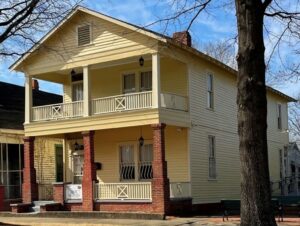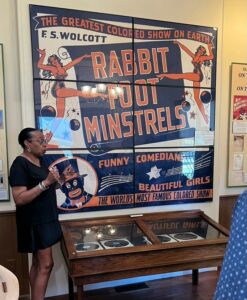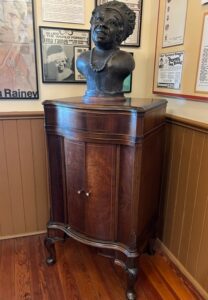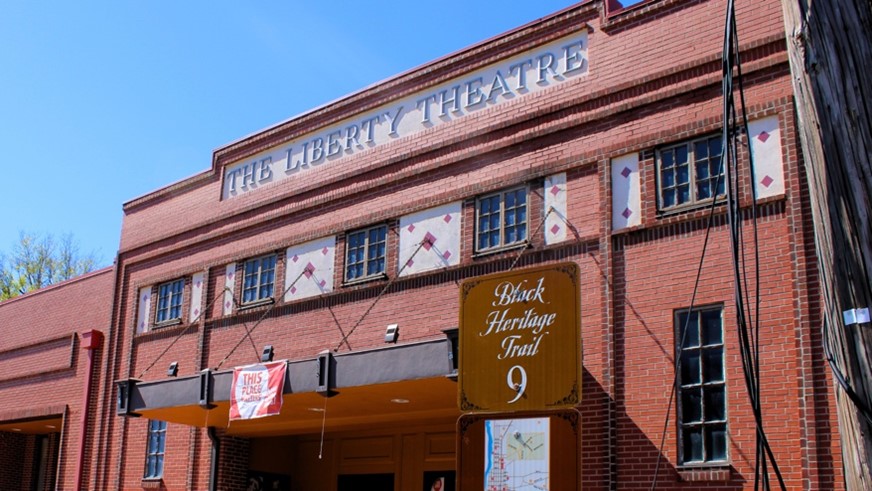From the (not so) Far-Flung Correspondence:
Columbus, Georgia’s Ma Rainey House and Museum: A Testament to the “Mother of the Blues”
This past June, I attended a music history conference in Columbus Georgia, where a significant portion was dedicated to exploring the blues through legendary singer Ma Rainey’s life and legacy. This conference’s segment culminated in a special tour of Rainey’s historic former home, and of other adjacent landmarks, offering a captivating glimpse into her life and the rich blues heritage of the region. The Ma Rainey House, showcases local blues history, fascinating exhibits, and authentic artifacts, providing a deeply immersive experience.
Gertrude “Ma” Rainey (Gertrude Pridget) played a pivotal role in shaping the blues idiom, bridging the gap between Bessie Smith’s classic-style blues and the “country blues” tradition of the Lower Chattahoochee River Valley. Journalist Chris Albertson aptly described Rainey’s impact, noting that she “introduced the earthy spirit of country blues to the stage, giving a tinge of the polish that characterized the work of her former collogues.”[1] Beyond her musical prowess, Rainey was a complete persona, far more than just a blues singer. On stage, she commanded attention with her powerful voice, delivering songs about love, heartbreak, and a woman’s determination, infused with a sharp wit and playful humor. However, beneath the surface, Rainey’s lyrics and music often delivered meaningful commentary about everyday life, far removed from the superficiality of the entertainment world. [2]

Ma Rainey’s illustrious career, marked by numerous affiliations and accomplishments, far surpasses the scope of this brief overview. Her journey to a recording contract with Paramount began on the Chitlin’ Circuit, a vital network of performance venues that embraced African American entertainers during the Jim Crow era.[3] In 1904, she began part of her three-decade touring career with F. S. Wolcott’s Rabbit Foot Minstrels—where she met William “Pa” Rainey—and later Tolliver’s Circus and Musical Extravaganza. Her rising fame helped secure a five-year partnership with Paramount, during which she recorded over 100 of her original compositions alongside some of the most celebrated musicians of the era. In 1935, Rainey retired to her hometown, moving into the house she bought on Columbus’s 5th Avenue.
Several esteemed organizations have recognized Ma Rainey’s enduring influence through numerous prestigious honors. The Blues Foundation inducted her into their Hall of Fame in 1983 and the Rock and Roll Hall of Fame in 1990 (Bonnie Raitt delivered her induction speech). Her native Georgia celebrated Rainey’s legacy by inducting her into both the Georgia Music Hall of Fame in 1992 and the Georgia Women of Achievement in 1993. In 1994, the U.S. Postal Service honored her contributions with a commemorative stamp, now displayed at the Ma Rainey House. The National Academy of Recording Arts and Sciences further acknowledged her monumental impact with a posthumous Lifetime Achievement Grammy Award in 2023, which is also on display. Additionally, Ma Rainey’s life was depicted in the 2020 feature film, Ma Rainey’s Black Bottom, directed by George C. Wolfe and Viola Davis playing Ma Rainey.
The Ma Rainey house stands as a testament to the love and unwavering dedication of the community to preserve Rainey’s important legacy in the very place where her life and career began. By the turn of the millennium, her former residence had fallen into disrepair and abandonment. However, in 2005, a determined effort arose to purchase the house and its surrounding property. The goal was to restore the structure to its original state, meticulously recreating the atmosphere of Rainey’ s life with its walls. The restoration included replicating details like paint colors, floral wallpaper, and even acquiring authentic pieces of Rainey’s furniture and other important belongings, including her piano, vinyl record player, and Victrola radio. Today, the house is festooned with captivating, curated displays of historical artifacts, photographs, and ephemera, offering visitors a glimpse into the life and times of the “Mother of the Blues. ”
”
Important to mention, our time with museum director Florence Dawkins was truly educational; her passion for her role in creating and oversight of the museum touched all of us there that day. The house is part of Columbus’s Parks and Recreation Department and located at 805 5th Avenue, Columbus, Georgia 31901. Tours are offered by appointment only: Monday–Friday 9:00 a.m.–3:00 p.m. | Saturday 10:00 a.m.–3:00 p.m. | Closed Sunday. Phone number: (706) 641-5933. Due to space constraints, groups of over six (6) should make reservations in advance. Groups will be taken through the museum six (6) persons at a time. The website is: https://parks.columbusga.gov/parks/ma-rainey-home. If you find yourself near Columbus, Georgia or if you are looking for a weekend jaunt, the Ma Rainey House is must-see.
Complementing the Ma Rainey House, the Columbus Museum is currently hosting “Crossroads: Chattahoochee Valley Blues and Folk Music,” an exhibit exploring the rich musical heritage of the region, including Ma Rainey’s connection to the Chattahoochee River Vally Blues. What makes this exhibition truly unique is its entirely student-curated nature. Under the guidance of musicologist Dr. Reba Wissner, students of the Public Musicology Certificate program at Columbus State University’s Schwob School of Music have meticulously crafted a fascinating display, showcasing their expertise in music history and cultural preservation. The exhibit will be on view until further notice. The Columbus Museum: 1251 Wynnton Rd. Columbus, GA 31906. https://columbusmuseum.com.
Last, I would be remiss if I did not mention Columbus’s remarkable restoration of its Liberty Theater, where Ma Rainey performed several times. Built in 1924–25, the Liberty Theater was the first in the area to welcome African American audiences during the Jim Crow era. Initially focused on cinema, the theater also boasted a stage that hosted an array of trailblazing black artists like Marian Anderson, Ella Fitzgerald, Ethel Waters, Lena Horne, and Bessie Smith. The Liberty also saw performances by legendary bands like Duke Ellington’s, Cab Calloway’s, and Fletcher Henderson’s. After closing in 1976, the Liberty remained abandoned until the Columbus Consolidated Government took ownership in 2023. Now, the Liberty Theater and Cultural Events Center stands as a testament to the rich legacy of black artists who performed there. While final renovations are underway (as of June 2024), visitors can consult the center’s website information about future events. 813 8th Ave. Columbus, GA 31901. (706) 604-1331. https://www.columbusga.gov/libertytheatre.
[1] Chris Albertson, “Ma Rainey,” Rock and Roll Hall of Fame. Accessed: July 13, 2024. https://rockhall.com/wp-content/uploads/2024/03/Ma_Rainey_1990.pdf.
[2] Ed Ward, “The Story of the Chitlin’ Circuit’s Great Performers,” NPR. Accessed: July 13, 2024. https://www.npr.org/2011/12/20/140596530/before-rock-n-roll-the-chitlin-circuit-performed.
[3] Ed Ward, “The Story of the Chitlin’ Circuit’s Great Performers,” NPR. Accessed: July 13, 2024. https://www.npr.org/2011/12/20/140596530/before-rock-n-roll-the-chitlin-circuit-performed.



